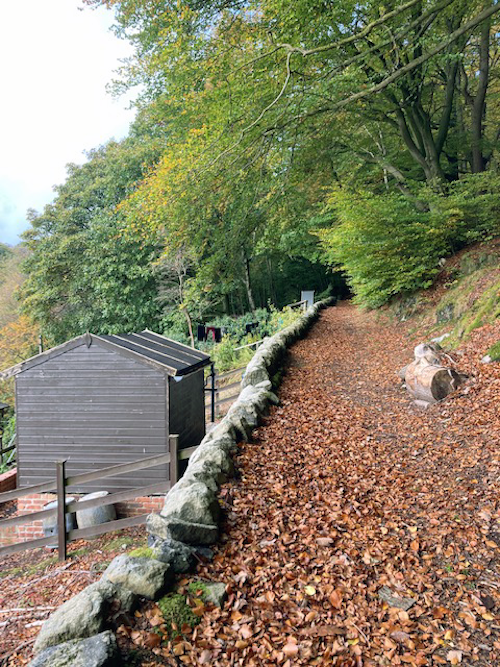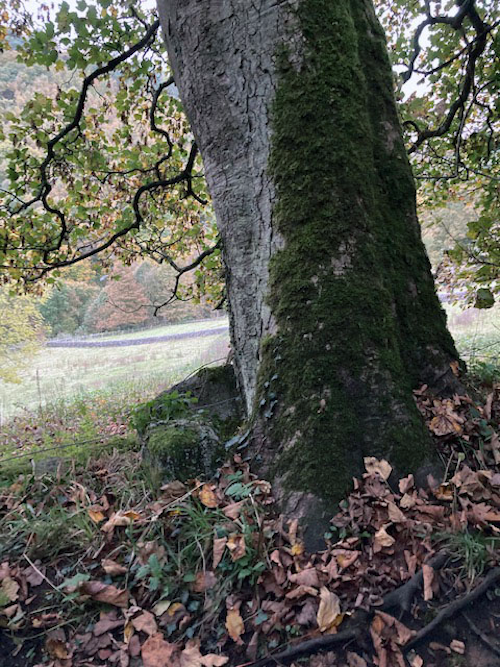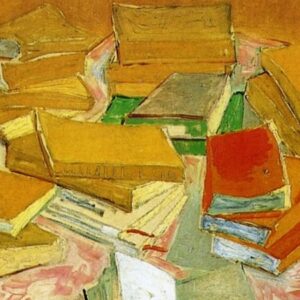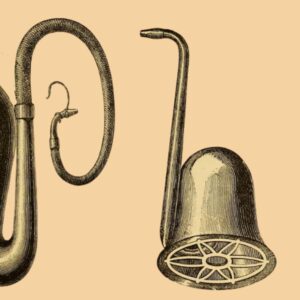
Diary of a Pilgrimage: Marking the Gravesite of Assia and Shura Wevill
Emily Van Duyne’s Tribute to a “Lover of Unreason and an Exile”
About a quarter mile from Sylvia Plath’s grave in Heptonstall, West Yorkshire, there is a wooded path, lined with sycamore and oak trees. The path is steep and slippery, and harder to get down than climb up. To find it, you cross over grassy hills, and go through two tiny gates, like something from a doll’s house. Stone stairs lead up to the first small gate; the other one opens to the same, carved into the hillside, sloping down toward a moss-covered stone wall, which you follow to the wooded path, lined with sycamore and oak trees.
At the top of the path is Lumb Bank, the 18th-century manor home that Ted Hughes bought in the early 1970s, shortly after his on-again off-again lover Assia Wevill killed herself and their daughter, Shura, in March of 1969. In the week before she ended her life, Wevill was in West Yorkshire with Hughes, looking for a home where they could live together. Lumb Bank wasn’t in the running at the time, but they saw several other homes, none of which seemed suitable.
Wevill was in despair; according to her journals of March 20, 1969, she asked Hughes why he couldn’t commit to a life with her, to marriage and their family. In the years since Plath’s 1963 suicide, Assia and Shura had often lived with Hughes, while she cared for his children with Sylvia, Frieda and Nicholas. But it always ended badly. “‘It’s Sylvia—it’s because of her,’” Wevill records him telling her: “Ted drunk—stroking my shoulder. The terrible talk in the ‘lounge’ of the Elm Hotel.” [1] The next day, Wevill went to Haworth, the village up the road where the Brontës lived and wrote and died, and bought Seconal sleeping pills from the druggist. Two days later, she dragged a mattress into the kitchen and killed herself and Shura in London flat.
 The path leading up to Lumb Bank. Photo by Emily Van Duyne
The path leading up to Lumb Bank. Photo by Emily Van Duyne
Ted Hughes took Assia Wevill to Lumb Bank with the intention to purchase it in 1963. In an unpublished note about this, held by the British Library, he describes the visit as a happy one. But the sale fell through, and the couple continued to bounce between London, Devonshire, and, for a time, the west coast of Ireland. Hughes’s note indicates that Assia loved Lumb Bank and wanted to live there, but it is almost impossible to imagine her living in Heptonstall, which even in 2022 feels shuttered and insular, trapped in time.
The stone is very old and the hills are very steep. Everywhere you look there is forbidding beauty. It rains and rains, and your boots slip on the cobblestones, so you move from the cobblestones to the sidewalks, which, in October, are slippery with fallen leaves. You are relieved to move to the crisscrossed walking paths of the surrounding woods, except that leaves blanket the uneven ground there, rocky with unseen stones, which gives way to mud and mulch. You never quite know what you’re stepping on. You feel the locals are onto you, and imagine, as you can’t help but do, the way they must have looked askance at a young Sylvia Plath, who visited for the first time in the late summer and early fall of 1956, after spending her honeymoon summer abroad in France and Spain with her new, elect husband.
Ted Hughes is a son of Heptonstall—at the top of a hill, with a view down to the village, sits his parents’ home, The Beacon, where the couple stayed during their visits. There is a famous picture of Plath from this time, perched on a stone wall with her typewriter, wearing her signature headband and a chic sweater. Even at young people’s Cambridge, where Plath was then studying English literature on a two-year Fulbright fellowship, her brightly-colored clothes marked her as a flashy American; she must have seemed like a movie star against the gray stones of Heptonstall.
In 1963, Assia Wevill was 36 years old, her beauty quite literally famous in cosmopolitan London. Like Hughes, she was dark, with almost-black hair that made her light-colored eyes jump from her face. Photographs of Wevill astonish those unfamiliar, or just learning, this terrible story—some audibly gasp. “They look exactly alike: the same color, shape, everything. She is his twin sister, & like his sister, barren, uncreative, a real vamp. All sophistication,” Sylvia Plath wrote of Ted Hughes and Assia Wevill, on October 21, 1962.
But I am more interested in the similarities between Sylvia and Assia: how, in Heptonstall, both must have felt like huge exotic birds forced into a gray stone cage, as villagers watched them wander through the town like kept women. How, like a man in a fairy story, Ted Hughes tried to take them both from the London life they thrived in, to his gray stone tower. It feels like a tower, this place. You could let down your hair; the rain would lash it to the stones, and there, like lichen, it would stay.
*
Two years before Assia Wevill died, she made an unofficial will with instructions for her burial. These included the specification that her body should reside in a country cemetery in England, for which she planned to pay the church £50, and that her gravestone should read, “Here lies a lover of unreason and an exile.” It is possible she was planning filicide even then; the beginning of the document gives instructions for who should receive Wevill’s money, “in the event of my daughter not surviving,” a line that sent a shudder through me. In the same document, she willed “all the lace, ribbons, and silks she can find, as well as a fine gold chain” to Frieda Hughes, to whom she also left her love, love she similarly granted to Frieda’s brother, Nicholas, whom she had cared for since he was a year-old—“my most tender love.” “I kissed Nick’s neck over and over again,” she wrote in a 1963 journal entry. “It kills me when he gurgles with it.”
I carved Assia’s epitaph into the clay: Here lies a lover of unreason and an exile.
It was my long understanding that Ted Hughes had scattered or buried Assia and Shura’s ashes at an unknown site. The closest to a real location I ever read about was in Jonathan Bate’s biography of Hughes, which claimed that Hughes scattered the ashes “in a rural Kentish graveyard, doing what he could to fulfill her wish for her body.” The line is unsourced.
So I was shocked to come across an article in The Ted Hughes Society Journal by the poet and Hughes scholar Steve Ely wherein he claimed to have uncovered their precise location. In “The Key of the Sycamore,” Ely wrote about Hughes’s “planning materials” for Capriccio, his short book of poetry about Assia, which included notes detailing the specifics of their burial in an unmarked grave.
Capriccio is a book that posits the idea that Assia’s suicide was fated from her birth and that Hughes’s actions had nothing to do with it. It was printed in a very limited run in the early 1990s—50 copies—and sold at two prices: $9,000 for the first 40, and $14,000 for 10 special editions. Hughes published it in collaboration with the sculptor Leonard Baskin, who he befriended when Baskin was teaching alongside Sylvia Plath at Smith College in the 1957-58 academic year.
The two became lifelong friends, and Baskin’s engravings were the covers for many of Hughes’s later books, most famously Crow, which he dedicated to Assia and Shura a year after their deaths. In one of the article’s many dissonant moments, Ely writes that Assia, “simply disappeared and was forgotten,” tacking a footnote about the Crow dedication onto the statement. He ends his article by commenting that some might object to his revealing the burial place of Assia and Shura as “a betrayal of Hughes’s apparent intention to keep the site secret,” without any apparent consideration of the possibility that this wasn’t Hughes’s decision to make in the first place—he wasn’t married to Assia, and both her father and sister were living at the time of her death.
Ely’s position seems close to that of many scholars of Hughes’s life and work: we only know of Assia Wevill because of Ted Hughes, therefore, any view of her legacy must be seen through his. Ely extends this line of thinking to Assia’s desired epitaph, which he believes was her “attempt to frame the post-mortem reception of her life, perhaps knowing that she would be posthumously recognized as an important character in the biography of a famous poet, if not for her own achievements.” He extends it even to Assia’s religion—Judaism—which Ely writes was “in many ways more important to Hughes than it was to her,” after arguing that, since Wevill’s father, not her mother, was Jewish, she was not actually Jewish, as the line is matrilineal.
Wevill was Jewish enough to have fled Hitler’s Germany with the rest of her family, fleeing first to Italy before settling in Palestine, where Assia and her sister, Celia, grew up, exiled from their homeland of Germany. She was Jewish enough to have specified burial, rather than cremation, of her body, since cremation is against Jewish law. “To Ted Hughes, their father,” Wevill wrote in her 1967 will, “I leave my no doubt welcome absence and my bitter contempt.”
*
The path lined with sycamores is, as Ely says, a public place, “frequented by dog walkers, mountain bikers, creative writers, tourists and hikers.” When I visited, I had the guidance of two of my English friends, who are familiar with the area, and an American who has relocated there. We had just enough daylight to get there. With us was the stone I had made earlier in the week with my aunt, a potter, and my 11-year-old son, who I took with me when I fled the violent relationship that nearly destroyed my life. I have been, almost, disappeared, which must be why I was compelled to make something permanent to mark the burial of Assia Wevill and her daughter, Shura, who was only four when her mother killed her in a murder-suicide.
 The stone on a spot where Assia Wevill and Shura Hughes are believed to be buried. Photo by Emily Van Duyne
The stone on a spot where Assia Wevill and Shura Hughes are believed to be buried. Photo by Emily Van Duyne
“I have wanted to efface myself,” Plath wrote in her great poem “Tulips,” a line that lives deep in my body, the place that thought, once, I’ll forget—I’ll forget all he’s done, to me, to our son, to other women, the cheating and the violence, I’ll forget, and it will be ok. But I could not forget, ever—not a single thing for a single hour of a single day—which must be why I took our son early one fall morning and fled.
Still, that woman, that woman longing to forget, still lives in me. I thought of her the day my son helped my aunt and I trim the ceramic gravestone we were sculpting for Assia and Shura, in my aunt’s art studio by the ocean, the same ocean I would have to cross in order to lay the stone down in its proper place beneath the sycamore, a week later.
“This feels powerful,” my English friend said as we walked over the Heptonstall hills toward Lumb Bank. “Doing this, with all of you. It feels powerful.” She had visited the spot in advance, to find the right place, or as close as we could get to it. Holding the stone—which I had lugged in my carry-on from Newark International Airport to Heathrow, then on the Tube, and then the train to Leeds, and then the train to Hebden Bridge, and then up the steep hill to Heptonstall—I walked in circles, looking at the trees and the rocks.
The sky darkened. I leaned down and nestled the stone at the base of the sycamore, in a hollow made by a gnarled root, which seemed to hug the hardened clay. “It will last about three years, and slowly dissolve into the earth,” my aunt told me. “In the meantime, we’ll make a larger, permanent one, and then bring it back.”
 The stone, placed at the presumed burial site for Assia Wevill and Shura Hughes. Photo by Emily Van Duyne
The stone, placed at the presumed burial site for Assia Wevill and Shura Hughes. Photo by Emily Van Duyne
It was about three years from the time I left my son’s violent father before I felt the ground beneath my feet again—before that, there was the sense that I was walking on water, being waked by a nearby boat. An American like Sylvia, I was raised on a barrier island, not the English moors which were, Plath wrote her mother, the only place where she didn’t miss the sea. I wanted to feel at home in those woods, but I did not, feeling, instead, the warmth of the women surrounding me as I placed the stone and my friend read Kaddish, the Jewish prayer for the dead often described as “the war against forgetting.”
After, as we walked up to one of Heptonstall’s two pubs in the dark, my other English friend held me back from the group. “You have to banish him,” she said, holding my arm gently, and staring intently at me with her brown eyes. “While you’re here. We should make a circle around you, and banish him.” She meant Ted Hughes, whose presence is nowhere larger than it is in Heptonstall near Lumb Bank, where he was once the lord of the manor, below which he buried his mistress and illegitimate daughter in an unmarked grave and then, after, according to one source, carved his initials into an adjacent tree.
But I could think of nothing but my ex, and the gradual magic he possessed to disappear the women who loved him. My friend’s brown eyes peered into my own in the falling dark and I saw, once more, my 11-year-old son’s hands as they pieced together a tiny Star of David, made from clay, to attach to Assia and Shura’s stone, while, with my own, I carved Assia’s epitaph into the clay: Here lies a lover of unreason and an exile. Ahead of us, in the gloaming, our friends’ bodies wavered out of view.
*
On my third day in West Yorkshire, I visited the Brontë Parsonage and purchased, in the gift shop, a tiny hanging sign that reads, “Better to be without logic than without feeling,” a quote from Charlotte’s novel The Professor. The phrase was with me as I trudged over the green hills of Heptonstall and down the path away from Lumb Bank, and it is with me now. How do you describe a feeling of surety, a general sense that something was, something is, something continues to be?
This is the chief problem of writing about Ted Hughes and Sylvia Plath, and, now, Assia Wevill—you know Hughes made it hard for these women, you know they feared him. You know he made it hard for the women who wanted to write about them. You know, somehow, he still does, although he is no more, scattered ashes somewhere on Dartmoor, a stony sign in Poets’ Corner in Westminster Abbey, the place where a state funeral was held for him as the Poet Laureate of England, the place where he was eulogized by the current king of England, who once referred to Hughes as his “unofficial spiritual adviser.”
You know it was hard for Princess Diana, too—you see, in her coltish legs and sly smile a trace of Sylvia Plath, just as you see traces of Plath in yourself, trapped, alone, far from home, trying to escape a crushing love with a sneering, violent poet. Coltish legs and memories both are, and are not, facts; traces have no logic. It is not possible to explain that as my friends and I crossed into a particular part of the woods below Lumb Bank, the temperature dropped suddenly, and an icy wind picked up. It is not possible to explain that it felt like a dangerous place, except to say—it felt like a dangerous place. It was a dangerous place. It told me to turn back, but I wouldn’t listen. The day before her suicide, Assia wrote, “The tenderness with which these terrible relationships are evoked, once the players are dead. Their lives are so compost for the sentimental bouquets of ‘compilers’ of the future.” I tried to find my footing. My boots sank into mulch.
 The woods near Lumb Bank. Photo by Emily Van Duyne
The woods near Lumb Bank. Photo by Emily Van Duyne
Lumb Bank is owned now by the Arvon Foundation, a literary nonprofit which offers arts workshops, retreats, and grants to practicing writers. Ted Hughes leased it to them in the 1970s. On my last day in England, I went there with a friend to record a panel on Sylvia Plath for the Open University of the United Kingdom. We recorded in the library, with its view of the wooded valley below. It was my first, and surely only, time being inside a home Ted Hughes had owned and occupied, and I quashed my discomfort by making jokes.
Inside the bathroom, I took a mirror selfie and pulled a face, then rounded the corner to peer into what was once his bedroom. “Assia and Shura’s ashes were there, in a closet, for years, in a plastic bag,” my friend told me, and I felt nothing but a rising anxiety, like the woman in a horror movie who, as the house hisses, Get out, fingers the crown molding with loving care.
When, at the end of the panel, I was asked what Sylvia Plath means to me, my throat tightened as I tried to answer. Tears came down my face. “She is a part of every single thing I’ve been and done,” I said, and then said, “Oh god, no, this is embarrassing.” My heart hurt, there, in that room, with its view of the wooded valley. It yearned to cross the sea and be home.
*
[1] All quotations from Wevill’s journals and will are taken from The Collected Writings of Assia Wevill. Ed. Julie Goodspeed-Chadwick and Peter K. Steinberg. Louisiana State University Press. 2021.
Emily Van Duyne
Emily Van Duyne's book Loving Sylvia Plath: A Reclamation is out with W.W. Norton & Co. An associate professor of writing at Stockton University, she is the recipient of fellowships from the Fulbright and Mid Atlantic Arts Foundations, and from Emory University. She lives in New Jersey with her husband and children, and is at work on a book about the history of campus sexual assault in the United States.












